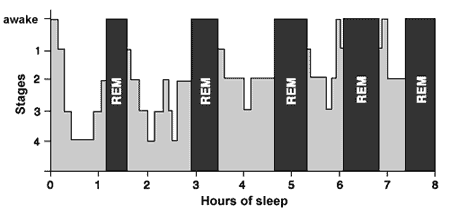Sleep Architecture: Stages of Sleep
Sleep is far more than just an unconscious mental state. Sleep researchers have determined that several stages of sleep with varying amounts of physical and mental activity occur predictably each night. These stages of sleep have been extensively studied, and are divided into two main types –
Rapid Eye Movement (REM) sleep, and
Non-Rapid Eye Movement (NREM) sleep.
REM sleep is characterized by tiny back-and-forth movements in the eye, and are typically accompanied by the visual and emotional world of vivid dreams. The eyes move in tandem, as they do normally during an awakened state. The tiny muscles in our inner ears move as if we’re hearing, even in complete silence. REM sleep typically comprises about 20-25% of sleep for most adults, although that percentage declines somewhat as we age. All of us dream, even though we may not remember the dreams.
REM sleep makes it appear as if we are watching and listening to what’s going on as we dream. Some scientists believe that the eye movements of REM sleep relate to the visual images of dreams, but why they exist and what function they serve, if any, remains largely unknown.
REM sleep includes very active brain activity, and if awakened during REM sleep many people will vividly remember their dreams. Our bodies are also much more active during REM sleep, with a higher heart rate, breathing, and blood pressure than during deep sleep. REM sleep is also characterized by a natural form of muscle paralysis, although this is the sleep phase when males often experience an erection, and females experience swelling of the clitoris.
During REM sleep, a deep inner part of the brain known as the pons blocks signals from the brain to the spinal cord, resulting in a form of paralysis. Sleep scientists theorize that such muscle paralysis is necessary to keep us from physically acting out our dreams.
NREM sleep is generally associated less with vivid dreaming, although studies have shown some form of dreaming activity to be a continuous process during sleep. NREM sleep is often divided into 4 distinct stages that represent different states of body and brain activity while falling asleep and during deep sleep.
Stage 1 sleep is drowsiness. It typically lasts about 5 to 10 minutes. The eyes are closed, but if awakened a person probably would say he or she has not slept. One of the goals of the STS is to help you more easily drift into this first drowsy phase of sleep, which then sets the stage for true sleep.
Stage 2 is deeper than Stage 1 drowsiness and a form of true sleep. The heart rate slows, respiration becomes slower and deeper, and body temperature decreases as it gets ready for deep sleep. However, an external noise or disturbance would easily awaken us from this light form of sleep. Stage 2 sleep may last 30 to 45 minutes.
If at times you feel you are lying in bed but not sleeping, yet somehow the hours seem to go by quickly – you probably are in fact lightly sleeping in Stage 2 or deeper. Keep this in mind as you work the STS – Stage 2 sleep counts as legitimate sleep. It is serving its purpose of helping refresh and rejuvenate you for another day.
Stages 3 and 4 are deep sleep, sometimes called slow-wave sleep, characterized by deep slow breathing and regular continuous rhythms of brain activity. Stage 4 shows deeper patterns than stage 3. We are for the most part cut off from the stimulation of the external world in deep sleep, and least likely to be awakened by a noise or other disturbance at these stages. The deep sleep stages may last around 45 minutes or so.
After stage 4 is reached, stages 3 and 2 repeat, then a period of REM or dreaming sleep is attained. So a typical progression is 1-2-3-4-3-2--REM.
In a typical night, each of these sleep cycles lasts from 90 to 110 minutes on average. The first few cycles of the night typically include longer stages 3 and 4, meaning the deepest sleep, with less REM dreaming. Later in the night, the amount of REM sleep and vivid dreaming increases in each successive cycle. Typically a person will have four to six of these cycles each night, and the amount of REM dreaming on the final cycle will be around an hour. Why sleep occurs in such cycles is currently unknown.

National Institutes of Health
A typical night for a young, healthy adult, showing 5 cycles of REM and NREM sleep. Light-gray areas represent non–rapid eye movement (NREM) sleep.